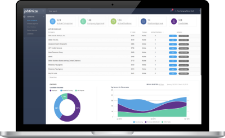Serving Up Stronger Performance and Fatter Margins in a Multinational Fast Casual Restaurant Chain
The client is the owner of five franchised locations within a North American chain of fast-service restaurants with strong brand loyalty. Attracting and keeping enough of the right employees has always been an ongoing challenge. Despite the resources offered to franchisees by Corporate, large ‘Now Hiring’ banners have long been a regular fixture at every location in the system.

In the Quick-Serve Restaurant (QSR) business, margins tend to be tight – and the difference between being highly profitable and losing your shirt can be razor-thin. It often comes down to the fine points of service execution. If employees are well-trained and well-suited to the task, the potential exists to build a very profitable business. This business in turn can support and nourish the communities it serves, but its success ultimately comes down to people.
This franchisee’s stores were having difficulty retaining front-line workers, and management staff felt overwhelmed by their duties. In their words, “Every day felt like a new crisis”. The symptoms were predictable – when one thing’s off, it tends to cascade quickly downhill in other areas as well. This was the starting point:
- Service quality was suffering and barely passing audits.
- Business performance targets as laid out by Corporate were being missed and profitability was suffering.
- Friction and performance issues internally chewed up management time and left them exposed to customers. The cracks were showing.
- Turnover was running more than 100% annually with a base staff of 145. With an estimated cost of $1,200 to hire and train a frontline employee turnover was a quarter-million-dollar issue in direct costs alone.
They needed a better approach to attracting, selecting, and retaining frontline staff while raising the bar for their managers.
The Solution
The solution started by studying the existing team, starting with the supervisors and managers. Like many companies in this industry, there had been a long history of promotion from within – which is perfectly valid. The problem was it wasn’t always the right people getting promoted. Strong customer service staff may be good subject-matter experts, but that alone does not make them management material.

Fit First used an assessment product to profile the existing management team and correlate the behavioral data against internal performance metrics. From the results, a reliable pattern for a ‘top performing manager’ was created for use in better informing hiring and promotion decisions. Additionally, individualized coaching guides were created for use in helping each person focus on their strengths. Perhaps the biggest dividend at this stage was the trust that was built quickly in the process, and the improved confidence and self-awareness on the part of those making ‘people’ decisions. Having and using a template was key.
The next step was to incorporate a lighter assessment for front-line hiring. This screen evaluated candidates’ attitudes in three critical areas – Integrity, Reliability, and Work Ethic. Simply put, is it likely that a given candidate will show up for their scheduled shifts and work the eight hours? Is there a risk that, presented with the opportunity, they might try to ‘get away’ with stealing time, money or property? This screen also generated interview guides unique to the candidate, for use in face-to-face interviews. This vastly increased managers’ confidence, removed subjectivity and improved the quality of their decisions.
The final piece of the solution was to build the client a website where candidates could learn about the company and the jobs. The candidates could introduce themselves by not only completing an online application form but also completing their entire first interview online. For any or all jobs. On their time.
The interview itself was very different from the standard approach. It focused on four critical aspects of fit – eliciting information from the candidate about what they responded well to (and didn’t) as it relates to fit with the manager, the job, the customers and co-workers they spend their day with, and the company.
In leading with these questions about fit, the company suddenly gained access to all sorts of valuable information about candidates’ standards, attitudes, and values. These elements were not well screened for in the past but are very highly predictive of how a candidate will settle in, how they are likely to perform and how long they will stay.
The Results
Over the first six months, things started to change in meaningful ways.

As Customer Service staff turned over, they were replaced by people who were a much stronger fit for the job and who had higher standards of performance. As the team began to strengthen, some of the weaker performers started to feel the heat and left on their own accord. As the team’s performance improved, managers were forced to keep up. Some who could not keep up were moved into different roles that were a much better fit for them; others were allowed to move on.
In terms of documented business performance metrics after the first six months, here’s what the client shared with us:
- Absenteeism went from being a reliable, daily occurrence – to a very occasional one. People who were on the schedule showed up for their shifts. Early, in uniform and ready to start.
- Involuntary turnover decreased significantly, from 27% to 18%.
- Service and financial performance improved dramatically:
- Food costs plummeted from 36% of revenue to 27%, putting thousands of dollars straight into the bottom line.
- Labor costs (payroll and related) decreased from 30% to 26%.
- Speed of service (critical metric) – the client went from the bottom in the region to being consistently in the top 3. One store reduced its average delivery time from 40 seconds to 25 seconds.
- They went from barely passing their Quality Service Audits, to ranking consistently in the 92nd percentile.
- The new management team was finally able to focus on higher-value activities. They were no longer firefighting. Front-line staff were following procedures, getting the job done in less time and with less friction – leaving managers to focus on coaching, communication, and on improving metrics.
Overall, the company was running better and more profitably. Customers were happier, and these were the first locations in the entire network able to take down their huge ‘Help Wanted’ banners. They had a large and growing pool of top-quality candidates to draw from, at a time when turnover was lower than ever.
The only disappointment? The one store that decided not to follow all three of the steps of the solution is consistently the lower-performing store of the five.
Key Learning for the Client
This client had spent a long time pushing for better results, striving for lower costs and higher service scores. The biggest realization was that everything they had been measuring, reporting, and trying to improve was a trailing indicator – the outcome of other things, done well or done poorly.
You can’t fix food costs, service times, or customer satisfaction by attacking those issues directly. If you don’t have the right people in the job, focused on the things that matter most, no program or initiative is ever going to get you where you need to be.
Fit, therefore, is the leading indicator. Fit with the manager, the job, the team and the company. When they align, and the right people are in the right roles, results will improve naturally. Everyone wins.

 Find a Solution
Find a Solution 


